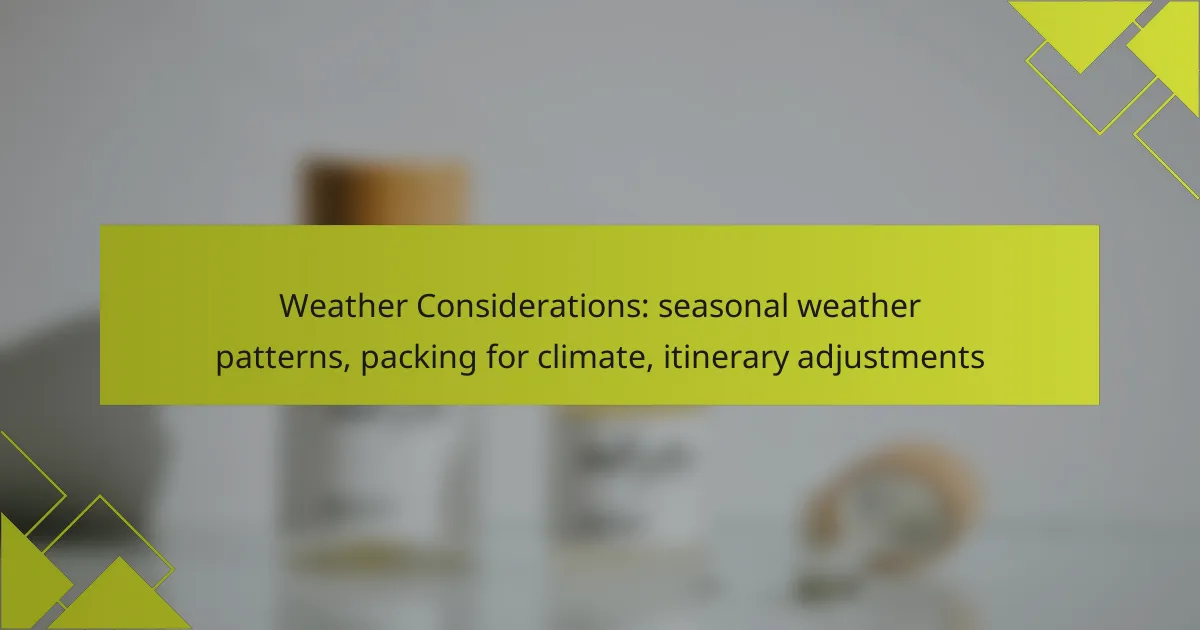When planning a trip, understanding seasonal weather patterns is crucial for making informed decisions about your destination and what to pack. By considering factors such as temperature, humidity, and precipitation, you can ensure you have the appropriate clothing and gear. Additionally, staying flexible with your itinerary allows you to adapt to changing weather conditions, enhancing your overall travel experience.

How do seasonal weather patterns affect travel plans?
Seasonal weather patterns significantly influence travel plans by determining the best times to visit certain destinations and what to pack. Understanding these patterns helps travelers avoid extreme conditions and enhance their overall experience.
Understanding seasonal variations
Seasonal variations refer to the changes in weather conditions that occur throughout the year, impacting temperature, precipitation, and daylight hours. For instance, summer often brings warmer temperatures and longer days, while winter can lead to colder weather and shorter days. Travelers should consider these variations when planning their trips to ensure comfort and enjoyment.
Different regions experience seasonal changes differently. Tropical areas may have wet and dry seasons, while temperate zones typically have four distinct seasons. Knowing the specific climate of your destination can help you prepare accordingly.
Impact on travel destinations
Weather patterns can greatly affect the appeal of various travel destinations. For example, ski resorts thrive in winter, while beach destinations are most popular during summer months. Rainy seasons can deter visitors from tropical locations, making it essential to check seasonal forecasts before booking.
Additionally, some destinations may have peak tourist seasons that coincide with favorable weather, leading to higher prices and crowded attractions. Conversely, traveling during off-peak seasons can offer better deals and a more relaxed experience, albeit with potential weather drawbacks.
Best times to visit popular locations
Identifying the best times to visit popular locations can enhance your travel experience. For instance, Europe is often best visited in late spring or early fall when temperatures are mild and crowds are smaller. In contrast, destinations like the Caribbean are most enjoyable during the dry season, typically from December to April.
For ski enthusiasts, planning trips between December and March maximizes snow conditions. Conversely, national parks in the U.S. are often best visited in late spring or early fall to avoid summer heat and crowds. Always check local weather patterns and peak seasons to optimize your travel itinerary.

What should I pack for different climates?
Packing for different climates requires understanding the specific weather conditions you will encounter. Consider the temperature, humidity, and potential precipitation to ensure you have the right clothing and gear for your trip.
Essential items for tropical climates
When traveling to tropical climates, prioritize lightweight, breathable fabrics that wick moisture away from your skin. Items like cotton shirts, shorts, and sandals are ideal for keeping cool in high humidity.
Don’t forget to pack essentials like sunscreen, a wide-brimmed hat, and insect repellent to protect against sunburn and bug bites. A light rain jacket can also be useful for sudden downpours common in tropical areas.
Winter packing list for cold destinations
For cold destinations, focus on thermal layers, waterproof outerwear, and insulated accessories. A good winter coat, thermal underwear, and warm socks are crucial for staying comfortable in low temperatures.
Accessories like gloves, scarves, and hats can make a significant difference in warmth. Consider packing waterproof boots to keep your feet dry and warm during snowy conditions.
Layering techniques for variable weather
Layering is key when dealing with variable weather, as it allows you to adjust your clothing based on temperature changes throughout the day. Start with a moisture-wicking base layer, add an insulating layer like a fleece, and finish with a waterproof outer layer.
Choose layers that can be easily added or removed, such as zippered jackets or cardigans. This flexibility helps you stay comfortable whether it’s chilly in the morning or warm by midday.

How can I adjust my itinerary based on weather forecasts?
Adjusting your itinerary based on weather forecasts involves monitoring conditions and being ready to change plans to ensure a comfortable experience. This can include rescheduling outdoor activities, choosing indoor alternatives, or even shifting travel dates if severe weather is expected.
Flexible scheduling strategies
Flexible scheduling allows you to rearrange your plans based on the latest weather updates. Consider booking accommodations and activities that offer free cancellation or rescheduling options. This way, you can shift your itinerary without incurring extra costs.
For example, if rain is forecasted for a particular day, you might move outdoor excursions to a sunnier day and plan indoor activities, like museum visits or cooking classes, for when the weather is less favorable.
Activities suitable for inclement weather
When planning for inclement weather, consider activities that can be enjoyed indoors. Options include visiting local galleries, attending workshops, or exploring historical sites that offer shelter. These activities can provide a rich experience even when the weather is not ideal.
Additionally, check for local events, such as theater performances or indoor markets, which can be great alternatives during rainy or cold days. Always have a backup plan ready to ensure your trip remains enjoyable regardless of the weather.
Using weather apps for real-time updates
Weather apps are essential tools for receiving real-time updates on conditions. Popular apps like AccuWeather or Weather.com provide hourly forecasts, radar maps, and alerts for severe weather, helping you make informed decisions quickly.
Set up notifications for your travel area to stay informed about sudden changes. This proactive approach allows you to adjust your itinerary on the go, ensuring you can take advantage of favorable weather whenever possible.

What are the best practices for planning around weather conditions?
To effectively plan around weather conditions, consider seasonal patterns, local climate, and potential weather disruptions. This approach helps ensure a more enjoyable and comfortable travel experience.
Researching local climate trends
Understanding local climate trends is essential for anticipating weather conditions during your trip. Check historical weather data for the destination, focusing on temperature ranges, precipitation levels, and seasonal variations.
For example, if traveling to a Mediterranean region, be aware that summers can be hot and dry, while winters may bring mild temperatures and occasional rain. Knowing these patterns allows for better packing and itinerary adjustments.
Consulting travel blogs for weather insights
Travel blogs often provide firsthand accounts of weather experiences in specific locations. These insights can reveal nuances that official forecasts may overlook, such as unexpected storms or local climate quirks.
Look for blogs that focus on your destination and time of year, as they may offer tips on what to pack and how to adjust your plans based on recent weather patterns. Engaging with the travel community can also yield valuable recommendations for navigating weather-related challenges.

How do weather considerations influence travel insurance?
Weather considerations significantly impact travel insurance by determining coverage options for cancellations and delays. Understanding these factors helps travelers choose appropriate policies that protect against climate-related disruptions.
Understanding coverage for weather-related cancellations
Travel insurance policies often include provisions for cancellations due to severe weather events, such as hurricanes or blizzards. It’s crucial to check if the policy covers cancellations resulting from weather forecasts or only from actual events.
Many insurers require a specific level of severity for weather events to qualify for claims. For example, a traveler’s flight may be canceled due to a forecasted storm, but if the storm does not reach the expected intensity, coverage might not apply. Always read the fine print regarding weather-related cancellations.
Choosing the right policy for climate risks
Selecting the right travel insurance policy involves assessing the climate risks of your destination. Areas prone to hurricanes, heavy snowfall, or monsoon seasons may require more comprehensive coverage. Consider policies that specifically mention weather-related disruptions in their terms.
When evaluating options, compare policies based on coverage limits, exclusions, and the types of weather events covered. Some policies may offer “cancel for any reason” options, which provide greater flexibility but often at a higher premium. Always ensure the policy aligns with your travel itinerary and the expected weather conditions during your trip.

What emerging trends should travelers consider regarding weather?
Travelers should be aware of how emerging trends, such as climate change and advancements in weather forecasting, are influencing travel planning. These factors can affect seasonal weather patterns, packing choices, and itinerary adjustments, making it essential to stay informed.
Impact of climate change on travel patterns
Climate change is altering traditional weather patterns, leading to unpredictable conditions that can affect travel. For example, regions that were once known for mild summers may experience extreme heat, while areas typically associated with dry seasons may face unexpected rainfall.
Travelers should consider adjusting their itineraries based on these changing conditions. For instance, visiting popular destinations during off-peak seasons may help avoid extreme weather and crowded tourist spots. Additionally, monitoring local climate reports can provide insights into the best times to travel.
Innovations in weather forecasting technology
Advancements in weather forecasting technology have significantly improved the accuracy of weather predictions. Tools such as real-time satellite imagery and advanced modeling techniques allow travelers to receive timely updates about weather changes, enabling better planning.
Travelers can leverage these innovations by using reliable weather apps that provide localized forecasts. It’s advisable to check weather conditions regularly leading up to a trip and to have contingency plans in place for unexpected weather events, such as rain gear or alternative indoor activities.



